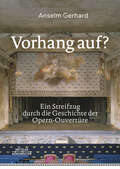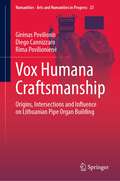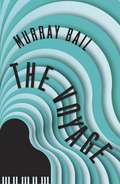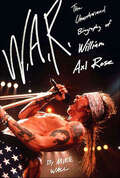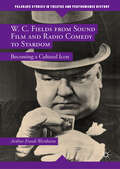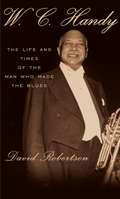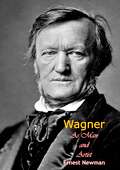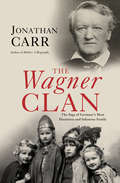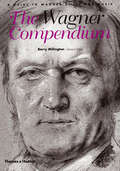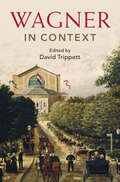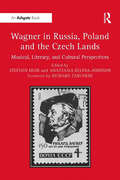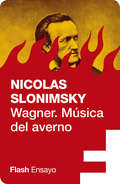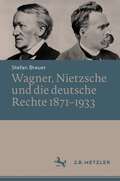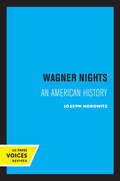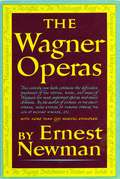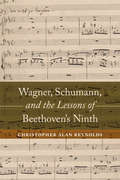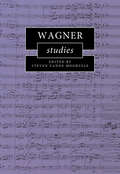- Table View
- List View
Vorhang auf?: Ein Streifzug durch die Geschichte der Opern-Ouvertüre
by Anselm GerhardDie Ouvertüre gehört zur Oper wie der Spitzenton in der höchsten Sopran- oder Tenor-Lage. Sollte man meinen. Dabei beginnt längst nicht jede Oper mit einer Ouvertüre. Dieses Buch beschreibt Erscheinungsformen und Funktionen der instrumentalen Einleitung im Musiktheater vom Barock bis in die Moderne. Der Blick ist dabei auf den Zusammenhang zwischen Eröffnungsmusik und Bühnenhandlung gerichtet, auf etwas, was in der Frühzeit der Oper gerade nicht angestrebt worden war, sich dann aber Schritt für Schritt entwickelte. So erzählt das Buch viele unbekannte Geschichten von konventionellen und vor allem unkonventionellen Lösungen, wie eine Oper eröffnet und ein Publikum zur Aufmerksamkeit gerufen wurde. Schon im 18. Jahrhundert gab es beispielsweise Pantomimen bei geöffnetem Vorhang – und zwar lange bevor ‚moderne‘ Opernregie solche Aktionen traditionellen Ouvertüren hinzuerfinden sollte. Auch davon ist, in einem Bogen von Monteverdis „Orfeo“ bis zu Brittens „Owen Wingrave“, die Rede.
Vox Humana Craftsmanship: Origins, Intersections and Influence on Lithuanian Pipe Organ Building (Numanities - Arts and Humanities in Progress #23)
by Girėnas Povilionis Diego Cannizzaro Rima PovilionienėThis book provides a thorough analysis focused on the sound expression produced by human-crafted musical instrument – a pipe organ, in which various components blend into a complex whole to produce a wide range of timbres. The sound produced by wooden and metal pipes of a variety of sizes is an integral part of the instrument’s unique character, while the organ stop is like its signature, from which one can judge about the size and style of the instrument, an organ building school or even an organ master, to which it is attributable. Precise identification of the name of the stop in accordance to both the pipework itself and the authentic inscriptions on the pipes is instrumental in investigating the geographic origins and authorship of an organ. The monograph focuses on the craftsmanship of complex and historically influential organ stop Vox humana. Its research and definition provides specific information distinguishing particular features in the variety of organ building traditions and discussing the differences in organ sound perception and production. The volume is aimed at art and music historians, as well as musicologists and scholars researching restoration techniques.The book contains supplemental material with video and audio material as well as photo-documentation of authentic Vox humana examples. The material is placed in the online catalog, which may be accessed by scanning the QR code in the appendix of the book.dsgdsgds
The Voyage
by Murray BailFrank Delage, a middle-aged Australian, arrives in Vienna with the most daring of propositions. He has invented a revolutionary piano and means to market it to the grand old world of classical music. A chance meeting with one Amalia von Schalla brings new possibilities - a soirée, an introduction to her daughter Elisabeth, dinner with an avant-garde composer. But when the sheer audacity of his campaign dawns on him, he takes a slow boat home to the southern hemisphere. As it meanders through the Mediterranean and the Suez Canal, he is afforded ample time to reflect on tensions between the old world and the new. And, for all his travails, he is not going home empty-handed...
The Voyage
by Murray BailFrank Delage, a middle-aged Australian, arrives in Vienna with the most daring of propositions. He has invented a revolutionary piano and means to market it to the grand old world of classical music. A chance meeting with one Amalia von Schalla brings new possibilities - a soirée, an introduction to her daughter Elisabeth, dinner with an avant-garde composer. But when the sheer audacity of his campaign dawns on him, he takes a slow boat home to the southern hemisphere. As it meanders through the Mediterranean and the Suez Canal, he is afforded ample time to reflect on tensions between the old world and the new. And, for all his travails, he is not going home empty-handed...
W.A.R.: The Unauthorized Biography of William Axl Rose
by Mike WallA biography that “captures the runaway-train spirit” of Guns N’ Roses singer Axl Rose and delves into what shaped him as a man and a musician (Kirkus Reviews).Even in the world of rock and roll, someone like Axl Rose doesn’t come along very often. Mercurial and brilliant, deluded and imperious, Rose defies easy description or analysis. Few people have studied Rose as closely as Mick Wall has. Traveling with Guns N’ Roses and writing about them in the late 1980s and early 1990s, Wall first earned Axl’s trust and later his fury.W.A.R. goes back to the beginning, revealing Rose’s childhood influences (and how he got his name), and tracking the birth of the band and their enormous success with albums like Appetite for Destruction and Use Your Illusion. With fame and money came substance abuse and infighting, and a lead singer who morphed from eccentric to seemingly unhinged.Wall’s book is richly detailed and offers surprising new views of a variety of Guns N’ Roses and Axl Rose incidents, including the death of two fans at a concert in England; Rose’s eventual split from every one of the other original band members; fights with perceived enemies like Kurt Cobain, Motley Crue’s Vince Neil and fashion designer Tommy Hilfiger; Rose’s refusal to show up at concerts throughout his career; and his many years as a virtual recluse at his Malibu mansion. W.A.R. is about great music, bad relationships, and the public and private personas of one of the most controversial performers of our time.“The best rock biography that has ever landed on my desk . . . turns the story of Axl Rose . . . into a profound examination of the pain of fame.” —The Tribune (UK)“A catalog of lawsuits, sackings, and all-round appalling behavior.” —The Daily Telegraph (UK)“It’s easy to paint Rose as a wrathful tyrant, but Wall has you sympathizing with [him].” —Entertainment Weekly
W. C. Fields from Sound Film and Radio Comedy to Stardom: Becoming a Cultural Icon (Palgrave Studies in Theatre and Performance History)
by Arthur Frank WertheimW. C. Fields is known as a virtuoso comedian and legendary iconoclast who gave the gift of laughter to multitudes. As the first author to use the newly-opened Fields Papers at the Academy library, Arthur Frank Wertheim illuminates the comedian’s arduous ascent to stardom during Hollywood's golden age. The book reveals details of Fields’s turbulent private life, from his wife's refusal to divorce, to his estranged son, and to his fleeting relationships with women. Here is a portrait of an aggrieved artist whose emotional anguish found refuge in his poignant comedy about life’s frustrations and the human condition. This third volume in Wertheim's trilogy documents Fields's rise to iconic status during the counterculture 1960s, creating a legacy of his comedy for generations to come.
W. C. Handy: The Life and Times of the Man Who Made the Blues
by David RobertsonBefore there was Elvis, there was W. C. Handy, "the man who made the blues. " Here is the first major biography in decades of the man who produced iconic songs and who was responsible, more than any other musician, for bringing the blues into the American mainstream.
Wading in Waist-High Water: The Lyrics Of Fleet Foxes
by Robin PecknoldA Vulture Most Anticipated Book of Fall A Powell's Holiday Pick for 2022 “There is something quite moving about seeing these fifty-five songs collected and assembled this way. Themes of family, friendship, love, destiny, loss, nature, and honest living bridge all of the albums and form the core set of concerns of this body of work. At the same time, you can see the evolution of the minds and hearts at work behind the lyrics.” —Brandon Taylor Since the release of their breakout debut album in 2008, Fleet Foxes and their front man, singer-songwriter Robin Pecknold, have enjoyed international critical and commercial acclaim. Their music has helped reshape the American indie-folk sound through songs that are acoustically and melodically driven, steeped in gospel-like harmonies, and propelled by Pecknold’s resonant, earthy, and timeless lyrics. Wading in Waist-High Water: The Lyrics of Fleet Foxes contains Pecknold’s complete lyrics from fifty-five songs, capturing the poetic and inventive storytelling that is a hallmark of the band’s music. These richly layered lyrics explore the complexity, darkness, and beauty of physical and emotional landscapes, both pastoral and modern. Accompanying the lyrics, Pecknold includes notes on his creative processes, inspirations, and motivations. With an introduction by celebrated novelist Brandon Taylor, and an afterword by Pecknold, Wading in Waist-High Water is a moving and intimate look at the art of songwriting, the joy of music-making, and what it means to produce meaningful and memorable sound.
Waging Heavy Peace
by Neil YoungThis beautiful limited edition will be signed by Neil Young and repackaged in a slip case and linen cover. Only 1,500 copies will be printed, making it an essential addition to every music lover’s collection. For the first time, legendary singer, songwriter, and guitarist Neil Young offers a kaleidoscopic view of his personal life and musical creativity. He tells of his childhood in Ontario, where his father instilled in him a love for the written word; his first brush with mortality when he contracted polio at the age of five; struggling to pay rent during his early days with the Squires; traveling the Canadian prairies in Mort, his 1948 Buick hearse; performing in a remote town as a polar bear prowled beneath the floorboards; leaving Canada on a whim in 1966 to pursue his musical dreams in the pot-filled boulevards and communal canyons of Los Angeles; the brief but influential life of Buffalo Springfield, which formed almost immediately after his arrival in California. He recounts their rapid rise to fame and ultimate break-up; going solo and overcoming his fear of singing alone; forming Crazy Horse and writing “Cinnamon Girl,” “Cowgirl in the Sand,” and “Down by the River” in one day while sick with the flu; joining Crosby, Stills & Nash, recording the landmark CSNY album, Déjà vu, and writing the song, “Ohio;” life at his secluded ranch in the redwoods of Northern California and the pot-filled jam sessions there; falling in love with his wife, Pegi, and the birth of his three children; and finally, finding the contemplative paradise of Hawaii. Astoundingly candid, witty, and as uncompromising and true as his music, Waging Heavy Peace is Neil Young’s journey as only he can tell it. .
Wagner: Beyond Good and Evil
by John DeathridgeJohn Deathridge presents a different and critical view of Richard Wagner based on recent research that does not shy away from some unpalatable truths about this most controversial of composers in the canon of Western music.
Wagner: Terrible Man & His Truthful Art
by M. Owen LeeHow is it possible for a seriously flawed human being to produce art that is good, true, and beautiful. Why is the art of Richard Wagner, a very imperfect man, important and even indispensable to us?In this volume, Father Owen Lee ventures an answer to those questions by way of a figure in Sophocles - the hero Philoctetes. Gifted by his god with a bow that would always shoot true to the mark, and indispensable to his fellow Greeks, he was marked by the same god with an odious wound that made him hateful and hated. Sophocles's powerful insight is that those blessed by the gods and indispensable to men are visited as well with great vulnerability and suffering.Wagner: The Terrible Man and His Truthful Art traces some of Wagner's extraordinary influence for good and ill on a century of art and politics - on Eliot and Proust as well as on Adolf Hitler - and discusses in detail Wagner's Tannhauser, the work in which the composer first dramatised the Faustian struggle of a creative artist in whom 'two souls dwell.' In the course of this penetrating study, Father Lee argues that Wagner's ambivalent art is indispensable to us, life-enhancing and ultimately healing.
Wagner and the Erotic Impulse
by Laurence DreyfusThough his image is tarnished today by unrepentant anti-Semitism, Richard Wagner (1813–1883) was better known in the nineteenth century for his provocative musical eroticism. In this illuminating study of the composer and his works, Laurence Dreyfus shows how Wagner’s obsession with sexuality prefigured the composition of operas such as Tannhäuser, Die Walküre, Tristan und Isolde, and Parsifal. Daring to represent erotic stimulation, passionate ecstasy, and the torment of sexual desire, Wagner sparked intense reactions from figures like Baudelaire, Clara Schumann, Nietzsche, and Nordau, whose verbal tributes and censures disclose what was transmitted when music represented sex. Wagner himself saw the cultivation of an erotic high style as central to his art, especially after devising an anti-philosophical response to Schopenhauer’s “metaphysics of sexual love.” A reluctant eroticist, Wagner masked his personal compulsion to cross-dress in pink satin and drench himself in rose perfumes while simultaneously incorporating his silk fetish and love of floral scents into his librettos. His affection for dominant females and surprising regard for homosexual love likewise enable some striking portraits in his operas. In the end, Wagner’s achievement was to have fashioned an oeuvre which explored his sexual yearnings as much as it conveyed—as never before—how music could act on erotic impulse.
Wagner As Man and Artist (Cambridge Library Collection - Music Ser.)
by Ernest NewmanERNEST NEWMAN was born in 1868. Educated at Liverpool College and Liverpool University, he had intended to enter the Indian Civil Service, but when his health broke down, he went instead, into business in Liverpool. In 1905 he became music critic of the Manchester Guardian and subsequently of the Birmingham Post. In 1920 he began his long career as music critic for the Sunday Times (London). Mr. Newman has written, translated, and edited numerous books, among which are his stories of the Great Operas (Volume I and II available in the Vintage series), and his celebrated four-volume biography The Life of Richard Wagner (1933, 1937, 1941, 1946). He died on July 7, 1959.“By all odds, this is Newman’s best full-length book—a triumph of concise biography.”—Jacques BarzunWagner as Man and Artist remains by far the best general introduction to the composer, because Newman admiration for the music did not blind him to the man’s unappealing character, nor to the slim value of his pronouncements on extra-musical matters;—Peter Heyworth in The Observer (London)
The Wagner Clan: The Saga of Germany's Most Illustrious and Infamous Family
by Jonathan CarrAn Economist Best Book of 2007, Jonathan Carr’s The Wagner Clan proves, with the sweeping scope of a Wagnerian opera, that the history of Europe and that of the infamous composer’s family are inextricably intertwined. Carr presents not only Richard Wagner himself- musician, philosopher, philanderer, failed revolutionary, and virulent anti-Semite-but also a colorful cast of historical figures who feature in Wagner’s story: Franz Liszt (whose illegitimate daughter Cosima married Wagner); Friedrich Nietzsche; Arthur Schopenhauer; Richard Strauss; Gustav Mahler; Arturo Toscanini; Joseph Goebbels; Hermann Göring; and the "Wolf ” himself, Adolf Hitler, a passionate fan of the Master’s music and an adopted uncle to Wagner’s grandchildren. Wagner’s British-born daughter-in-law, Winifred, was a close friend of Hitler’s and seemed momentarily positioned to marry him after the death of her husband. All through the war the Bayreuth Festival, begun by the Master himself, was supported by Hitler, who had to fill the audience with fighting men and SS officers. After the war’s devastation, the festival was dark for a decade until Wagner’s offspring-with characteristic ambition and cunning- revived it. The Wagner Clan is a riveting chronicle of the ascent, decline, and rehabilitation of the German nation and its most infamous family.
The Wagner Clan: The Saga of Germany's Most Illustrious and Infamous Family
by Jonathan CarrollA well-researched account of the composer Richard Wagner's later life and the lives of his contentious descendants down to the present.
The Wagner Compendium: A Guide To Wagner's Life and Music
by Barry MillingtonThe unrivaled single-volume survey of Wagner's life and work Edited by one of the leading Wagner scholars of modern times, and with contributions from seventeen experts from around the world, The Wagner Compendium is the key to a complete understanding of the composer-- the most comprehensive, informative and well-organized guide to his life and times. Features include: calendar of Wagner's life, works and related events who's who of Wagner's contemporaries details of historical, intellectual and musical background exploration of Wagner's character and opinions full list of Wagner's prose writings comprehensive listing and discussion of the works
Wagner in Context (Composers in Context)
by David TrippettFew composers embodied wider cultural interests than Wagner or had greater cultural consequences. This is the first collection to examine directly the rich array of intellectual, social and cultural contexts within which Wagner worked. Alongside fresh accounts of historical topics, from spa culture to racial theory, sentient bodies to stage technology, America to Spain, it casts an eye forward to contexts of Wagner's ongoing reception, from video gaming to sound recording, Israel to Friedrich Kittler, and twenty-first century warfare. The collection brings together an international cast of leading authorities and new voices. Its 42 short chapters offer a reader-friendly way into Wagner studies, with authoritative studies of central topics set alongside emerging new fields. It sheds new light on previously neglected individuals such as Minna Wagner, Theodor Herzl and Houston Stewart Chamberlain, and investigates/assesses/examines the global circulation of Wagner's works, his approach to money, and the controversies that continue to accompany him.
Wagner in Russia, Poland and the Czech Lands: Musical, Literary and Cultural Perspectives
by Anastasia Belina-Johnson Stephen MuirRichard Wagner has arguably the greatest and most long-term influence on wider European culture of all nineteenth-century composers. And yet, among the copious English-language literature examining Wagner's works, influence, and character, research into the composer’s impact and role in Russia and Eastern European countries, and perceptions of him from within those countries, is noticeably sparse. Wagner in Russia, Poland and the Czech Lands aims to redress imbalance and stimulate further research in this rich area. The eight essays are divided in three parts - one each on Russia, the Czech lands and Poland - and cover a wide historical span, from the composer’s first contacts with and appearances in these regions, through to his later reception in the Communist era. The contributing authors examine his influences in a wide range of areas such as music, literary and epistolary heritage, politics, and the cultural histories of Russia, the Czech lands, and Poland, in an attempt to establish Wagner’s place in a part of Europe not commonly addressed in studies of the composer.
Wagner. Música del averno (Flash Ensayo)
by Nicolas SlonimskyNicolas Slonimsky nos presenta aquí un delicioso recopilatorio de descarnadas, venenosas e ingeniosas críticas musicales al compositor Richard Wagner. «Esta música solo puede despertar los instintos más bajos. La música de Wagner invoca al cerdo más que al ángel. Y lo que es peor, ensordece a ambos. Es música de un eunuco enloquecido.»Le Figaro, París, 26 de julio de 1876. «La música de Wagner es la que más me gusta. Suena tan fuerte que uno puede hablar todo el tiempo sin que nadie oiga lo que dice.»Oscar Wilde Este compendio de críticas a Wagner aparece en el libroRepertorio de vituperios musicales (Taurus, 2016).
Wagner, Nietzsche und die deutsche Rechte 1871–1933
by Stefan BreuerDieses Buch befasst sich mit der Wirkung Richard Wagners und Friedrich Nietzsches auf die Ideologien der radikalen Rechten, die in der einen oder anderen Form Eingang in die Sammlungsbewegung des Nationalsozialismus gefunden haben. Es konzentriert sich also auf die Rezeption durch die intellektuelle Rechte des Kaiserreichs und der Weimarer Republik, die zur Analyse des Nationalsozialismus wie der neuen Rechten durch die Erhellung der Vorgeschichte der Ideologien beiträgt. Zwei Kapitel widmen sich dem theoretischen Werk Wagners und dem Werk Nietzsches und den Beziehungen der beiden Leitfiguren des späten 19. Jahrhunderts untereinander.
Wagner Nights: An American History (California Studies in 19th-Century Music #9)
by Joseph HorowitzAs never before or since, Richard Wagner's name dominated American music-making at the close of the nineteenth century. Europe, too, was obsessed with Wagner, but—as Joseph Horowitz shows in this first history of Wagnerism in the United States—the American obsession was unique. The central figure in Wagner Nights is conductor Anton Seidl (1850-1898), a priestly and enigmatic personage in New York musical life. Seidl's own admirers included the women of the Brooklyn-based Seidl Society, who wore the letter "S" on their dresses. In the summers, Seidl conducted fourteen times a week at Brighton Beach, filling the three-thousand-seat music pavilion to capacity. The fact that most Wagnerites were women was a distinguishing feature of American Wagnerism and constituted a vital aspect of the fin-de-siècle ferment that anticipated the New American Woman. Drawing on the work of such cultural historians as T. Jackson Lears and Lawrence Levine, Horowitz's lively history reveals an "Americanized" Wagner never documented before. An entertaining and startling read, a treasury of operatic lore, Wagner Nights offers an unprecedented revisionist history of American culture a century ago. This title is part of UC Press's Voices Revived program, which commemorates University of California Press’s mission to seek out and cultivate the brightest minds and give them voice, reach, and impact. Drawing on a backlist dating to 1893, Voices Revived makes high-quality, peer-reviewed scholarship accessible once again using print-on-demand technology. This title was originally published in 1994.
The Wagner Operas
by Ernest NewmanIn this classic guide, the foremost Wagner expert of our century discusses ten of Wagner's most beloved operas, illuminates their key themes and the myths and literary sources behind the librettos, and demonstrates how the composer's style changed from work to work. Acclaimed as the most complete and intellectually satisfying analysis of the Wagner operas, the book has met with unreserved enthusiasm from specialist and casual music lover alike. Here, available for the first time in a single paperback volume, is the perfect companion for listening to, or attending, The Flying Dutchman, Tannhäuser, Lohengrin, Tristan and Isolde, Die Meistersinger, the four operas of the Ring Cycle, and Parsifal. Newman enriches his treatment of the stories, texts, and music of the operas with biographical and historical materials from the store of knowledge that he acquired while completing his numerous books on Wagner, including the magisterial Life of Richard Wagner. The text of The Wagner Operas is filled with hundreds of musical examples from the scores, and all the important leitmotifs and their interrelationships are made clear in Newman's lucid prose. "This is as fine an introduction as any ever written about a major composer's masterpieces. Newman outlines with unfailing clarity and astuteness each opera's dramatic sources, and he takes the student through the completed opera, step by step, with all manner of incidental insight along the way. "--Robert Bailey, New York University
Wagner, Schumann, and the Lessons of Beethoven's Ninth
by Christopher Alan ReynoldsIn this original study, Christopher Alan Reynolds examines the influence of Beethoven's Ninth Symphony on two major nineteenth-century composers, Richard Wagner and Robert Schumann. During 1845-46 the compositional styles of Schumann and Wagner changed in a common direction, toward a style that was more contrapuntal, more densely motivic, and engaged in processes of thematic transformation. Reynolds shows that the stylistic advances that both composers made in Dresden in 1845-46 stemmed from a deepened understanding of Beethoven's techniques and strategies in the Ninth Symphony. The evidence provided by their compositions from this pivotal year and the surrounding years suggests that they discussed Beethoven's Ninth with each other in the months leading up to the performance of this work, which Wagner conducted on Palm Sunday in 1846. Two primary aspects that appear to have interested them both are Beethoven's use of counterpoint involving contrary motion and his gradual development of the "Ode to Joy" melody through the preceding movements. Combining a novel examination of the historical record with careful readings of the music, Reynolds adds further layers to this argument, speculating that Wagner and Schumann may not have come to these discoveries entirely independently of each other. The trail of influences that Reynolds explores extends back to the music of Bach and ahead to Tristan and Isolde, as well as to Brahms's First Symphony.
Wagner Studies (Cambridge Composer Studies)
by Steven Vande MoorteleWhile the music of Richard Wagner has long served as a touchstone for music-theoretical and analytical models both old and new, music analysts have often been intimidated by the complexity of his works, their multi-layeredness, and their sheer unwieldiness. This volume brings together ten contributions from an international roster of leading Wagner scholars of our time, all of which engage in some way with analytical or theoretical questions posed by Wagner's music. Addressing the operas and music dramas from Die Feen through Parsifal, they combine analytical methods including form-functional theory, Neo-Riemannian theory, Leitmotiv analysis, and history of theory with approaches to dramaturgy, hermeneutics, reception history, and discursive analysis of sexuality and ideology. Collectively, they capture the breadth of analytical studies of Wagner in contemporary scholarship and expand the reach of the field by challenging it to break new interpretative and methodological ground.
Wagner Without Fear: Learning To Love--And Even Enjoy--Opera's Most Demanding Genius
by William BergerDo you cringe when your opera-loving friends start raving about the latest production of Tristan? Do you feel faint just thinking about the six-hour performance of Parsifal you were given tickets to? Does your mate accuse you of having a Tannhäuser complex? If you're baffled by the behavior of Wagner worshipers, if you've longed to fathom the mysteries of Wagner's ever-increasing popularity, or if you just want to better understand and enjoy the performances you're attending, you'll find this delightful book indispensable. William Berger is the most helpful guide one could hope to find for navigating the strange and beautiful world of the most controversial artist who ever lived. He tells you all you need to know to become a true Wagnerite--from story lines to historical background; from when to visit the rest room to how to sound smart during intermission; from the Jewish legend that possibly inspired Lohengrin to the tragic death of the first Tristan. Funny, informative, and always a pleasure to read,Wagner Without Fearproves that the art of Wagner can be accessible to everyone. Includes: - The strange life of Richard Wagner--German patriot (and exile), friend (and enemy) of Liszt and Nietzsche - Essential opera lore and "lobby talk" - A scene-by-scene analysis of each opera - What to listen for to get the most from the music - Recommended recordings, films, and sound tracks
